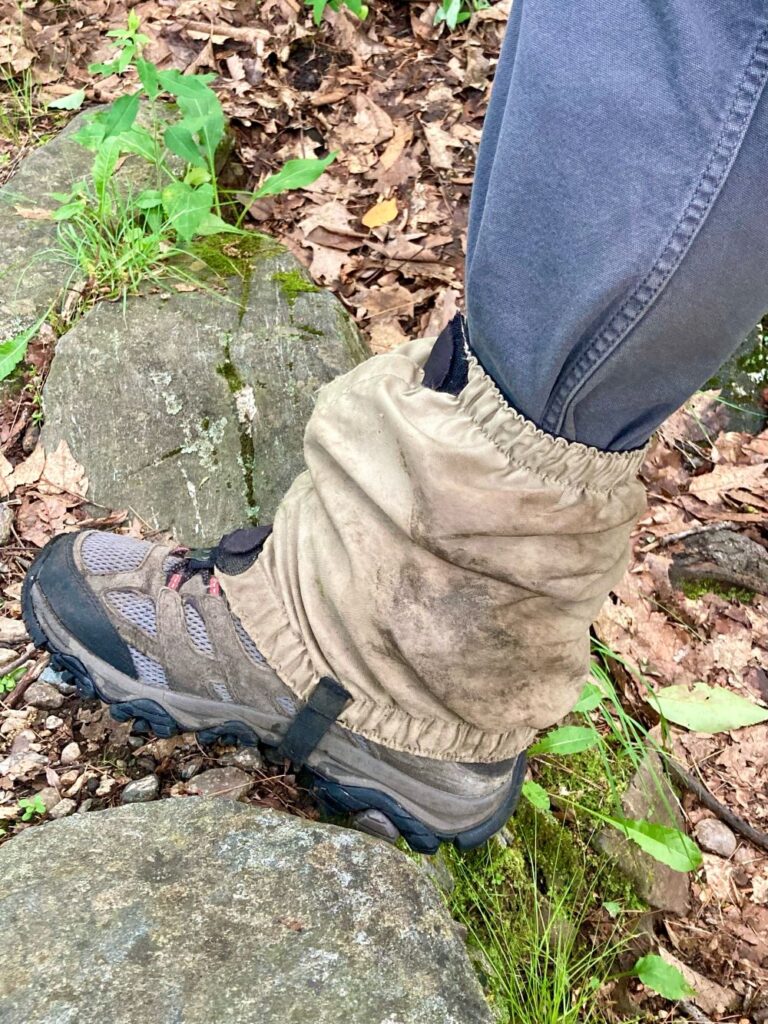A Summer Outdoors Begins with Tick Prevention
By Kelly Kandra Hughes

Forester Dave Beers recommends wearing ankle gaiters as stylish protection from ticks.
The Norfolk Land Trust (NLT) wants everyone to be extra aware of ticks this summer. “It’s already a heavy tick season,” says NLT board member Bill Couch. “Everyone needs to take extra precautions this year.”
One of the primary concerns with tick bites is Lyme disease, caused by Borrelia bacteria spread through the bite of an infected blacklegged tick. According to the 2023 Connecticut Active Tick Surveillance Map, approximately 25 percent of adult female deer ticks and six percent of nymph deer ticks tested in Norfolk carried Lyme disease. Early symptoms of the disease include fever, headache and a characteristic bull’s-eye rash. If left untreated, more severe complications can arise, affecting the joints, heart and nervous system.
Aside from Lyme disease, ticks in Connecticut can transmit other illnesses, such as anaplasmosis, babesiosis and powassan virus. Anaplasmosis causes flu-like symptoms and can be particularly severe in elderly or immunocompromised individuals. Babesiosis, caused by parasites that infect red blood cells, can range from mild symptoms to life-threatening complications in vulnerable populations.
The 2023 tick test rates in Norfolk for anaplasmosis and babesiosis were each at six percent for nymphal ticks, with no sampled female adult ticks testing positive. Powassan virus, though rare, can lead to severe neurological problems and even death in some cases. Although no sampled Norfolk ticks tested positive for this virus in 2023, samples from Westport and Groton did include two percent positive test rates for adult female deer ticks.
According to NLT board member Gail Savage, the Connecticut Agricultural Experiment Station (CAES) will test ticks for specific diseases for free, but she says results might take some time owing to the large volume of ticks submitted. According to the CAES website, all ticks are accepted for identification but only those that have a risk of transmitting the causative agents of Lyme disease, anaplasmosis and babesiosis are tested. More information can be found at: https://portal.ct.gov/caes/tick-office/tick-office/information-on-submitting-ticks.
Savage says she is aware of two other sites, UConn (https://cvmdl.uconn.edu/tick-testing/options/) and TickReport (https://www.tickreport.com/tick-test-pricing), that charge a fee to test ticks for disease and may provide results more quickly.
Preventing tick bites is crucial for reducing the risk of disease. David Beers, a longtime Norfolk resident and a forester for the state of Connecticut, has had relative success in staying tick-disease free, even though he spends the majority of his time outdoors. “I’m in the woods most days for work and play,” says Beers, “and it’s been well over 20 years since I last had Lyme disease. For me, two habits are key. One: I always wear tick-proof, permethrin-treated ankle gaiters. They look way cooler and are more effective than socks-over-pants. Two: an evening body scan.”
The Centers for Disease Control and Prevention offer additional tips to prevent tick bites. They advise those venturing into wooded or grassy areas to wear long-sleeved shirts and closed-toe shoes. They also recommend using insect repellents containing DEET on exposed skin and permethrin on clothing and gear. Hikers are advised to stay in the center of trails and to shower soon after returning indoors to wash off any unattached ticks. Any found on the body can be removed with fine-tipped tweezers, followed by a cleaning the area with soap and water or alcohol.
Anyone who suspects they have been bitten by a tick and develops symptoms such as fever, rash or flu-like illness should seek medical attention promptly and inform their healthcare provider of any recent outdoor activities. Early detection and treatment are key to effectively managing tick-borne illnesses.
